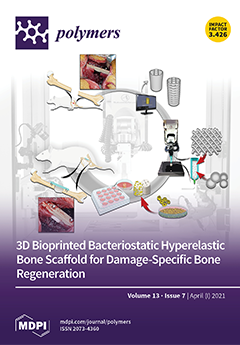We report the synthesis of hybrid thin films based on polymethyl methacrylate) (PMMA) and polystyrene (PS) doped with 1%, 3%, 5%, and 7% of cerium dioxide nanoparticles (CeO
2 NPs). The As-prepared thin films of (PMMA-PS) incorporated with CeO
2 NPs are deposited
[...] Read more.
We report the synthesis of hybrid thin films based on polymethyl methacrylate) (PMMA) and polystyrene (PS) doped with 1%, 3%, 5%, and 7% of cerium dioxide nanoparticles (CeO
2 NPs). The As-prepared thin films of (PMMA-PS) incorporated with CeO
2 NPs are deposited on a glass substrate. The transmittance T% (λ) and reflectance R% (λ) of PMMA-PS/CeO
2 NPs thin films are measured at room temperature in the spectral range (250–700) nm. High transmittance of 87% is observed in the low-energy regions. However, transmittance decreases sharply to a vanishing value in the high-energy region. In addition, as the CeO
2 NPs concentration is increased, a red shift of the absorption edge is clearly observed suggesting a considerable decrease in the band gap energy of PMMA-PS/CeO
2 NPs thin film. The optical constants (n and k) and related key optical and optoelectronic parameters of PMMA-PS/Ce NPs thin films are reported and interpreted. Furthermore, Tauc and Urbach models are employed to elucidate optical behavior and calculate the band gaps of the as-synthesized nanocomposite thin films. The optical band gap energy of PMMA-PS thin film is found to be 4.03 eV. Optical band gap engineering is found to be possible upon introducing CeO
2 NPs into PMMA-PS polymeric thin films as demonstrated clearly by the continuous decrease of optical band gap upon increasing CeO
2 content. Fourier-transform infrared spectroscopy (FTIR) analysis is conducted to identify the major vibrational modes of the nanocomposite. The peak at 541.42 cm
−1 is assigned to Ce–O and indicates the incorporation of CeO
2 NPs into the copolymers matrices. There were drastic changes to the width and intensity of the vibrational bands of PMMA-PS upon addition of CeO
2 NPs. To examine the chemical and thermal stability, thermogravimetric (TGA) thermograms are measured. We found that (PMMA-PVA)/CeO
2 NPs nanocomposite thin films are thermally stable below 110 °C. Therefore, they could be key candidate materials for a wide range of scaled multifunctional smart optical and optoelectronic devices.
Full article






